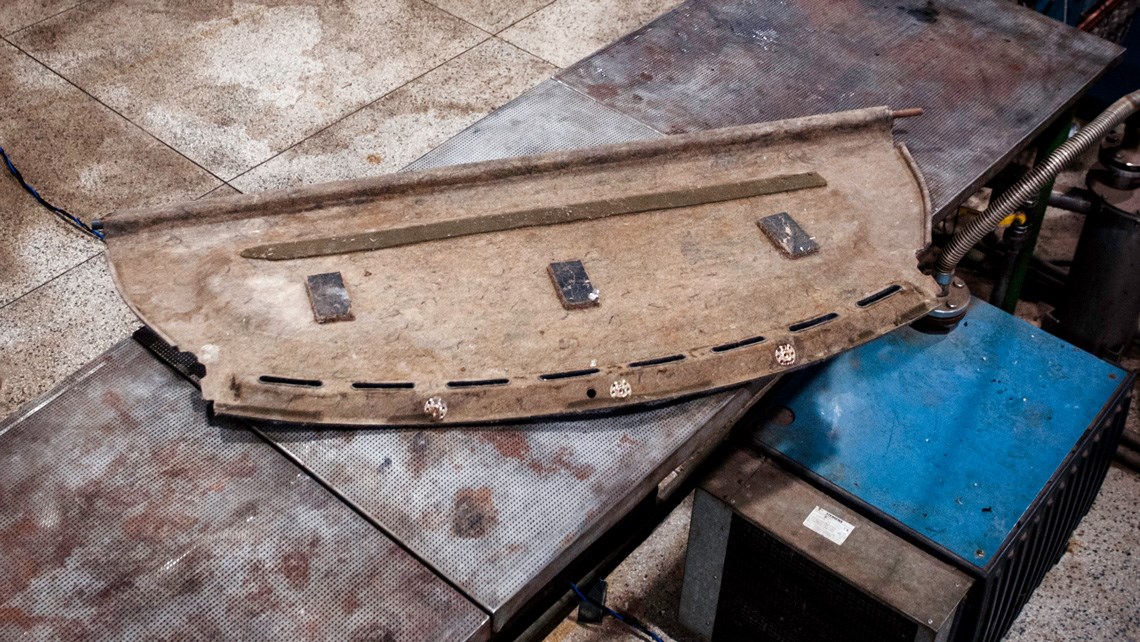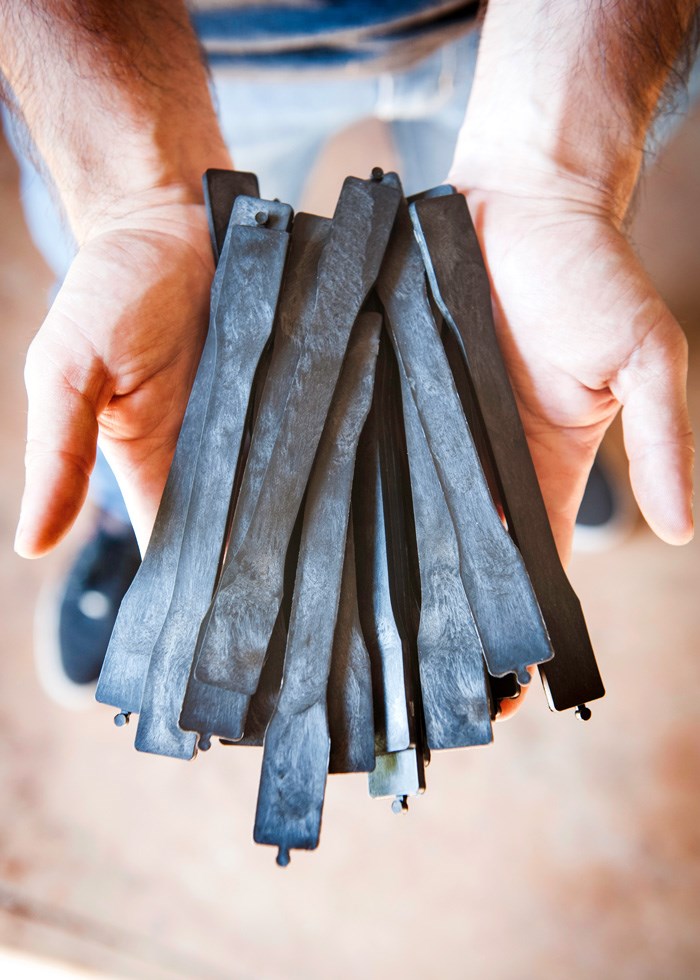Long considered one of the principal culprits responsible for emitting the greenhouse gases that cause global warming, the transportation sector is seeking ways to become more sustainable and has been investing in products and manufacturing processes with lower environmental impacts. The automotive industry has been using an alternative that is increasingly gaining traction throughout the world: employing natural fibers from vegetative sources in the manufacture of parts and accessories. More than just a raw materials supplier, Brazil has become a hub for researching and developing the technology.
In August, São Paulo State University (UNESP) signed an agreement with Volkswagen Brazil to develop new composites that include vegetable fibers in their formulation. (Composites are materials made up of two or more components, such as glass and metal; with the composite materials exhibiting properties superior to the individual materials they were made from.) The goal is for these new materials to be used in parts for the interior trim of the automaker’s cars.

Léo Ramos Chaves / Pesquisa FAPESP Magazine An automotive component manufactured using a biocompoundLéo Ramos Chaves / Pesquisa FAPESP Magazine
The project is led by agronomist Alcides Lopes Leão and chemist Ivana Cesarino, coordinators of the Bioprocesses and Biotechnology Lab at the School of Agricultural Sciences at UNESP, in Botucatu, São Paulo State, and will run for 18 months. At the end of this period, Volkswagen expects to have more sustainable parts by reducing the use of fossil-based plastic in their fabrication, and, more importantly, with vehicles that are lighter and more energy-efficient. The main advantage of replacing mineral ingredients with vegetable fibers, which are a less dense raw material, is to reduce vehicle weight, and consequently, fuel consumption. Some limitations, however, still need to be overcome, such as natural fibers’ low resistance to moisture and susceptibility to fungi, and their durability.
Leão has been studying the use of plant fibers in composite materials since the 1990s. The current partnership with Volkswagen is an inheritance from a project funded by FAPESP in 2000 (see Pesquisa FAPESP issue no. 104). At that time, Leão was investigating the potential of curauá fiber (Ananas erectifolius), a variety of pineapple bromeliad native to the Amazon Rainforest that he had discovered while fishing in the region’s rivers.
The project aroused the interest of Volkswagen, which even produced a few automotive parts with the fiber, and the researcher was invited to give lectures on the subject to the company’s engineers in Brazil and Germany. But the automaker couldn’t find a regular supplier of curauá and shelved the project. Two decades later, Leão was surprised to receive a new invitation. “I was no longer in contact with anyone at Volkswagen. They decided to invest in producing parts using vegetable fibers and found me this year by searching the internet,” the researcher says.
Today, to define the best fiber to incorporate into the plastic, four options are being tested: coconut, jute, sisal, and bamboo. Although the issue of supply availability will weigh in the decision, the researcher believes now the balance has tipped. “Since the current project will have global reach, Germany can count on finding fiber suppliers in several countries,” he observes. Initially, the fibers will be incorporated into the polymer on a micrometric scale in six of the parts that make up the trunk of the Polo model. Afterward, the idea is to work on the nanometric scale. “The incorporation of nanocellulose doubles the composite’s resistance,” explains Leão.

Léo Ramos Chaves / Pesquisa FAPESP Magazine Test pieces made from bamboo fiberLéo Ramos Chaves / Pesquisa FAPESP Magazine
The researcher explains that natural fibers are already used in different types of composites, on a small scale, by several car manufacturers around the world. “The biggest consumer is the German automaker Mercedes-Benz, which uses around 30 kilos of fiber per vehicle. At Volkswagen, we’ll start with approximately 8 kilos per vehicle. When you realize that the company manufactures six million cars a year, the volume could be significant,” he says. In these composite materials, the polymer resin acts as the matrix, responsible for its structure, and the fiber as the reinforcing element. The use of fiber alone to manufacture automotive parts would not provide the resistance that the material needs.
Developing high-performance materials for the automotive industry from the region’s raw materials is also the objective of a team from the federal universities of Paraíba (UFPB) and Campina Grande (UFCG) and the Fraunhofer Institute for Manufacturing Technology and Advanced Materials, based in Bremen, Germany. The project is funded by the Paraíba State Research Support Foundation (FAPESQ) and the German Ministry of Education and Research. In Brazil, the study is being coordinated by materials engineer Renate Wellen, from the Department of Materials Engineering at UFPB.
The researchers started the project working with sisal fibers, in Brazil, and flax, in Germany. “The best properties were obtained with flax, which molds more like fabric to incorporate better into the composite, through compression. The objective is to use the material on the door interior, which was chosen due to its high demand within the industry and because it’s a less complex structure,” notes Wellen.
Similar to UNESP’s project with Volkswagen, the partnership between Brazilian and German researchers was also born from internet searches. This time, it was Brazilians who took the initiative. Committed to developing projects in the field of plant fiber materials science and aware of Germany’s growing interest in green technology, in 2015 Wellen initiated contacts with several German universities and research institutes.
Auto parts made with plant fibers are lighter and result in lower fuel consumption
These contacts resulted in her postdoctoral work at the Fraunhofer Institute for Manufacturing Technology and Advanced Materials, in Bremen, and the current project. For Wellen, now general coordinator of UFPB research, the exchange of experience between the teams is one of the most important aspects of the agreement. “There’s been an improvement in the training of students. We have two team members doing PhDs in Germany.”
The new natural-fiber-reinforced polymer is in its final phase. A prototype of an automotive part made from the material was presented in October at the K 2022 Fair, the largest international event in the plastics and rubber industry, held in Düsseldorf, Germany. There is already the prospect of developing a new composite material, potentially made with coconut fiber, an abundant raw material in Brazil. “The Germans are interested in continuing the partnership,” says Wellen.
From soy car to fiber cement
The attempt to use natural fibers in the automotive sector goes way back. In 1930, Henry Ford, the pioneer in automotive assembly-line production, created a material named bioplastic. Its exact composition is uncertain, as no record of the formula was kept, but in 1941 a prototype produced with the material became known as the soybean car. The new automobile, however, never entered the factory’s production line.
According to information from the Benson Ford Research Center, a research institute maintained by the Henry Ford Museum, the outbreak of World War II (1939–1945) suspended all automobile production in the United States. As a result, the soybean car experiment did not evolve. Afterward, the company’s efforts were directed toward recuperating the losses caused by the war and the bioplastic automobile fell into oblivion.

Léo Ramos Chaves / Pesquisa FAPESP Magazine A composite specimen made with natural fiber being submitted to a resistance testLéo Ramos Chaves / Pesquisa FAPESP Magazine
For chemical engineer Sandro Amico, coordinator of the Composite and Nanocomposite Materials Group at the Federal University of Rio Grande do Sul (UFRGS), another factor that contributed to the industry’s lack of interest was the appearance of glass and carbon fibers in the decades from 1930 to 1950. He explains that synthetic fibers had advantages such as high rigidity and greater mechanical resistance to chemical and environmental effects, while natural fibers were susceptible to humidity and other factors. Today, this problem can be circumvented by treating the fibers or by using additives in the composite formulation, and concern for the environment has brought natural fibers back to the industrial scene.
Amico has been working with different types of fiber for over two decades. “Today there are several examples of applications that didn’t exist five years ago and others that have increased in scale,” the professor notes. As an example, he cites WPCs (wood-polymer composites) known as plastic wood, which appeared in the 1960s and are formulated using wood sawdust and a thermoplastic polymeric resin, such as PVC or polyethylene. “This material has been a great commercial success in North America,” he says.
At the Federal Technological University of Paraná (UTFPR), students of forestry engineer Ugo Leandro Belini, from the Department of Industrial Design and the Graduate Program in Urban Environmental Sustainability, investigate how to make more sustainable products, such as light fixtures and corrective glasses. One of their ideas attracted interest from a local business. “In a course graduation research project, eyeglass frames were created from a composite of sugarcane bagasse particles dyed with a natural dye, turmeric, and bonded with castor bean polyurethane resin,” Belini says.
According to a market analysis published in 2020 by the American consulting firm Grand View Research, the market for composites produced with natural fiber is growing worldwide. The company estimates that the sector will be valued at US$10.9 billion by 2024. The construction industry uses more natural fiber composites than any other sector, accounting for more than half of overall demand. Abroad, WPC—plastic wood—is the material consumed most, and is used in floors, door and window frames, and paneling. Fibers are also used in concrete structural elements.

Léo Ramos Chaves / Pesquisa FAPESP Magazine A plate glass holder created with wood fiberLéo Ramos Chaves / Pesquisa FAPESP Magazine
In Brazil, fiber cement roofing tiles made with a mixture of cement and asbestos, a mineral fiber known to be carcinogenic, were banned in 2017, opening the way for new composites from plant sources. Civil engineer Holmer Savastano Junior, from the School of Zootechnics and Food Engineering at the University of São Paulo (FZEA-USP), who led the development of a fiber cement tile made from cellulosic pulp that was patented in 2012, is now leading a project to produce cement sheets reinforced by a three-dimensional structure of jute and mallow plant fiber.
According to the researcher, who has been studying the use of vegetable fibers in the production of tiles since the 1990s (see Pesquisa FAPESP issue no. 98), the jute and mallow fabric sheets, when juxtaposed and perpendicularly linked, form a structure that is lightweight and provides greater mechanical and chemical resistance than the product patented ten years ago. The project receives support from FAPESP and the State of Amazonas Research Support Foundation (FAPEAM), through a scientific cooperation agreement that brings together researchers from USP and the Federal University of Amazonas (UFAM).
“The team from Amazonas has expertise in polymer matrices and knots in fiber cement layers. There is a complementarity and exchange of learning experiences,” says Savastano. With the ban on the use of asbestos, he sees good prospects for marketing the new roof panels. “Since it doesn’t present any risk of toxicity, fiber cement has also been considered for internal use in room dividers, paneling and flooring, which may increase demand for the new product in the construction sector.”
Projects
1. Production of composites based on natural fibers (no. 06/06464-1); Grant Mechanism Research Partnership for Technological Innovation (PITE); Principal Investigator Alcides Lopes Leão (UNESP); Investment R$242,035.63.
2. Development of sustainable sandwich panels with cementitious faces reinforced with 3D jute and mallow fabric and a polymeric core (no. 20/08975-4); Grant Mechanism Regular Research Grant; Agreement FAPEAM; Principal Investigator Holmer Savastano Junior (USP); Investment R$152,568.94.
Scientific article
JÚNIOR, I. B. et al. Fibras vegetais e compósitos na indústria automotiva. Mix Sustentável, vol. 6, no. 4, aug. 2020.


